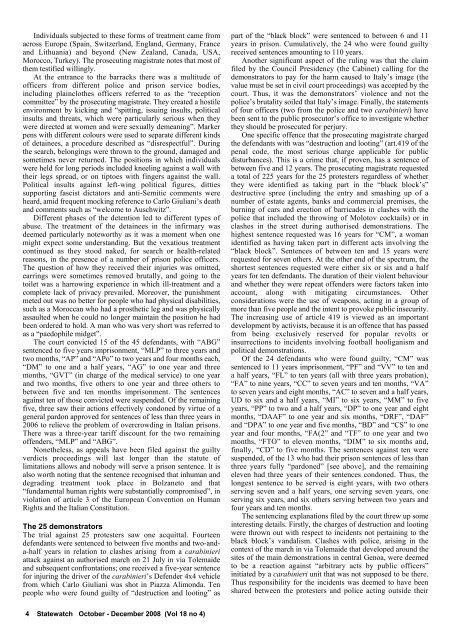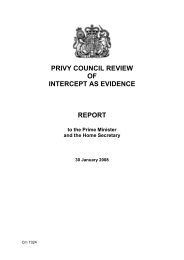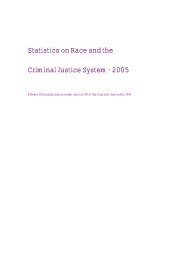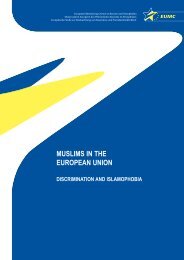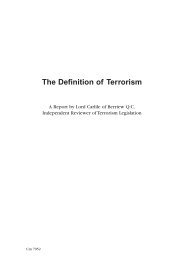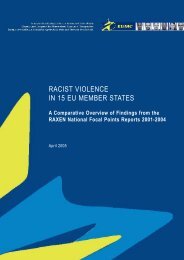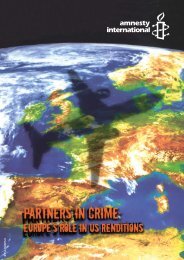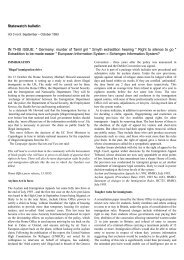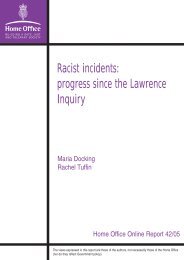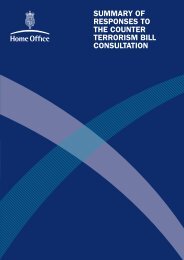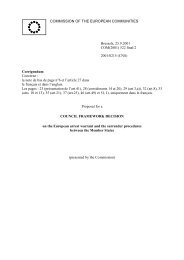Vol 18 no 4 - Statewatch
Vol 18 no 4 - Statewatch
Vol 18 no 4 - Statewatch
You also want an ePaper? Increase the reach of your titles
YUMPU automatically turns print PDFs into web optimized ePapers that Google loves.
Individuals subjected to these forms of treatment came from<br />
across Europe (Spain, Switzerland, England, Germany, France<br />
and Lithuania) and beyond (New Zealand, Canada, USA,<br />
Morocco, Turkey). The prosecuting magistrate <strong>no</strong>tes that most of<br />
them testified willingly.<br />
At the entrance to the barracks there was a multitude of<br />
officers from different police and prison service bodies,<br />
including plainclothes officers referred to as the “reception<br />
committee” by the prosecuting magistrate. They created a hostile<br />
environment by kicking and “spitting, issuing insults, political<br />
insults and threats, which were particularly serious when they<br />
were directed at women and were sexually demeaning”. Marker<br />
pens with different colours were used to separate different kinds<br />
of detainees, a procedure described as “disrespectful”. During<br />
the search, belongings were thrown to the ground, damaged and<br />
sometimes never returned. The positions in which individuals<br />
were held for long periods included kneeling against a wall with<br />
their legs spread, or on tiptoes with fingers against the wall.<br />
Political insults against left-wing political figures, ditties<br />
supporting fascist dictators and anti-Semitic comments were<br />
heard, amid frequent mocking reference to Carlo Giuliani’s death<br />
and comments such as “welcome to Auschwitz”.<br />
Different phases of the detention led to different types of<br />
abuse. The treatment of the detainees in the infirmary was<br />
deemed particularly <strong>no</strong>teworthy as it was a moment when one<br />
might expect some understanding. But the vexatious treatment<br />
continued as they stood naked, for search or health-related<br />
reasons, in the presence of a number of prison police officers.<br />
The question of how they received their injuries was omitted,<br />
earrings were sometimes removed brutally, and going to the<br />
toilet was a harrowing experience in which ill-treatment and a<br />
complete lack of privacy prevailed. Moreover, the punishment<br />
meted out was <strong>no</strong> better for people who had physical disabilities,<br />
such as a Moroccan who had a prosthetic leg and was physically<br />
assaulted when he could <strong>no</strong> longer maintain the position he had<br />
been ordered to hold. A man who was very short was referred to<br />
as a “paedophile midget”.<br />
The court convicted 15 of the 45 defendants, with “ABG”<br />
sentenced to five years imprisonment, “MLP” to three years and<br />
two months, “AP” and “APo” to two years and four months each,<br />
“DM” to one and a half years, “AG” to one year and three<br />
months, “GVT” (in charge of the medical service) to one year<br />
and two months, five others to one year and three others to<br />
between five and ten months imprisonment. The sentences<br />
against ten of those convicted were suspended. Of the remaining<br />
five, three saw their actions effectively condoned by virtue of a<br />
general pardon approved for sentences of less than three years in<br />
2006 to relieve the problem of overcrowding in Italian prisons.<br />
There was a three-year tariff discount for the two remaining<br />
offenders, “MLP” and “ABG”.<br />
Nonetheless, as appeals have been filed against the guilty<br />
verdicts proceedings will last longer than the statute of<br />
limitations allows and <strong>no</strong>body will serve a prison sentence. It is<br />
also worth <strong>no</strong>ting that the sentence recognised that inhuman and<br />
degrading treatment took place in Bolzaneto and that<br />
“fundamental human rights were substantially compromised”, in<br />
violation of article 3 of the European Convention on Human<br />
Rights and the Italian Constitution.<br />
The 25 demonstrators<br />
The trial against 25 protesters saw one acquittal. Fourteen<br />
defendants were sentenced to between five months and two-anda-half<br />
years in relation to clashes arising from a carabinieri<br />
attack against an authorised march on 21 July in via Tolemaide<br />
and subsequent confrontations; one received a five-year sentence<br />
for injuring the driver of the carabinieri’s Defender 4x4 vehicle<br />
from which Carlo Giuliani was shot in Piazza Alimonda. Ten<br />
people who were found guilty of “destruction and looting” as<br />
part of the “black block” were sentenced to between 6 and 11<br />
years in prison. Cumulatively, the 24 who were found guilty<br />
received sentences amounting to 110 years.<br />
A<strong>no</strong>ther significant aspect of the ruling was that the claim<br />
filed by the Council Presidency (the Cabinet) calling for the<br />
demonstrators to pay for the harm caused to Italy’s image (the<br />
value must be set in civil court proceedings) was accepted by the<br />
court. Thus, it was the demonstrators’ violence and <strong>no</strong>t the<br />
police’s brutality soiled that Italy’s image. Finally, the statements<br />
of four officers (two from the police and two carabinieri) have<br />
been sent to the public prosecutor’s office to investigate whether<br />
they should be prosecuted for perjury.<br />
One specific offence that the prosecuting magistrate charged<br />
the defendants with was “destruction and looting” (art.419 of the<br />
penal code, the most serious charge applicable for public<br />
disturbances). This is a crime that, if proven, has a sentence of<br />
between five and 12 years. The prosecuting magistrate requested<br />
a total of 225 years for the 25 protesters regardless of whether<br />
they were identified as taking part in the “black block’s”<br />
destructive spree (including the entry and smashing up of a<br />
number of estate agents, banks and commercial premises, the<br />
burning of cars and erection of barricades in clashes with the<br />
police that included the throwing of Molotov cocktails) or in<br />
clashes in the street during authorised demonstrations. The<br />
highest sentence requested was 16 years for “CM”, a woman<br />
identified as having taken part in different acts involving the<br />
“black block”. Sentences of between ten and 15 years were<br />
requested for seven others. At the other end of the spectrum, the<br />
shortest sentences requested were either six or six and a half<br />
years for ten defendants. The duration of their violent behaviour<br />
and whether they were repeat offenders were factors taken into<br />
account, along with mitigating circumstances. Other<br />
considerations were the use of weapons, acting in a group of<br />
more than five people and the intent to provoke public insecurity.<br />
The increasing use of article 419 is viewed as an important<br />
development by activists, because it is an offence that has passed<br />
from being exclusively reserved for popular revolts or<br />
insurrections to incidents involving football hooliganism and<br />
political demonstrations.<br />
Of the 24 defendants who were found guilty, “CM” was<br />
sentenced to 11 years imprisonment, “PF” and “VV” to ten and<br />
a half years, “FL” to ten years (all with three years probation),<br />
“FA” to nine years, “CC” to seven years and ten months, “VA”<br />
to seven years and eight months, “AC” to seven and a half years,<br />
UD to six and a half years, “MI” to six years, “MM” to five<br />
years, “PP” to two and a half years, “DP” to one year and eight<br />
months, “DAAF” to one year and six months, “DRF”, “DAF”<br />
and “DPA” to one year and five months, “BD” and “CS” to one<br />
year and four months, “FA(2” and “TF” to one year and two<br />
months, “FTO” to eleven months, “DIM” to six months and,<br />
finally, “CD” to five months. The sentences against ten were<br />
suspended, of the 13 who had their prison sentences of less than<br />
three years fully “pardoned” [see above], and the remaining<br />
eleven had three years of their sentences condoned. Thus, the<br />
longest sentence to be served is eight years, with two others<br />
serving seven and a half years, one serving seven years, one<br />
serving six years, and six others serving between two years and<br />
four years and ten months.<br />
The sentencing explanations filed by the court threw up some<br />
interesting details. Firstly, the charges of destruction and looting<br />
were thrown out with respect to incidents <strong>no</strong>t pertaining to the<br />
black block’s vandalism. Clashes with police, arising in the<br />
context of the march in via Tolemaide that developed around the<br />
sites of the main demonstrations in central Ge<strong>no</strong>a, were deemed<br />
to be a reaction against “arbitrary acts by public officers”<br />
initiated by a carabinieri unit that was <strong>no</strong>t supposed to be there.<br />
Thus responsibility for the incidents was deemed to have been<br />
shared between the protesters and police acting outside their<br />
4 <strong>Statewatch</strong> October - December 2008 (<strong>Vol</strong> <strong>18</strong> <strong>no</strong> 4)


